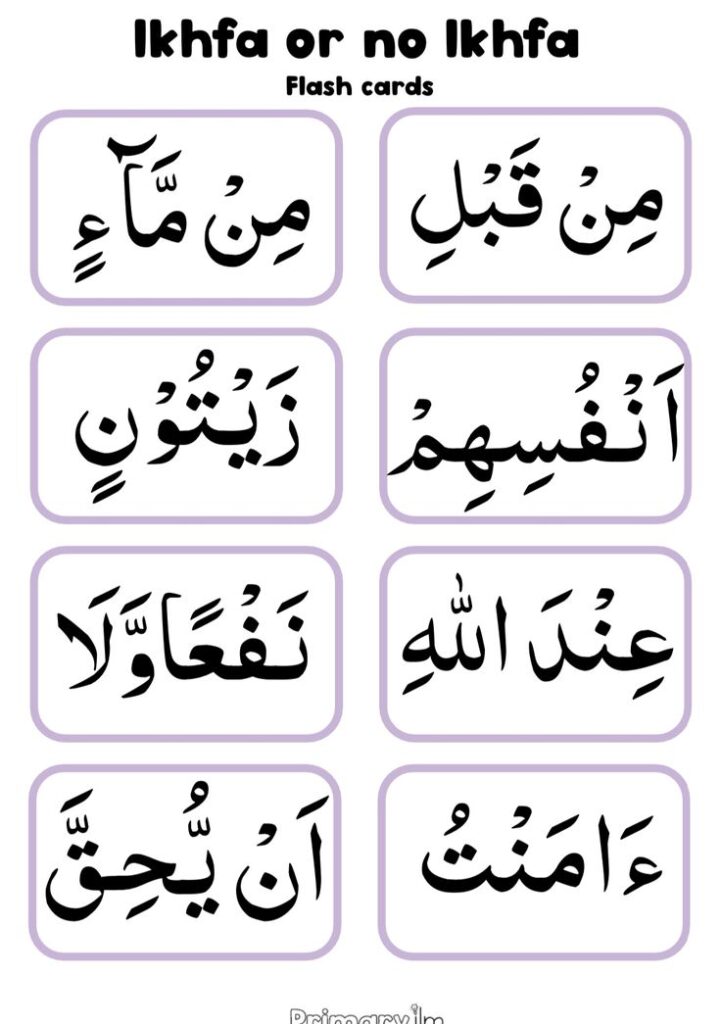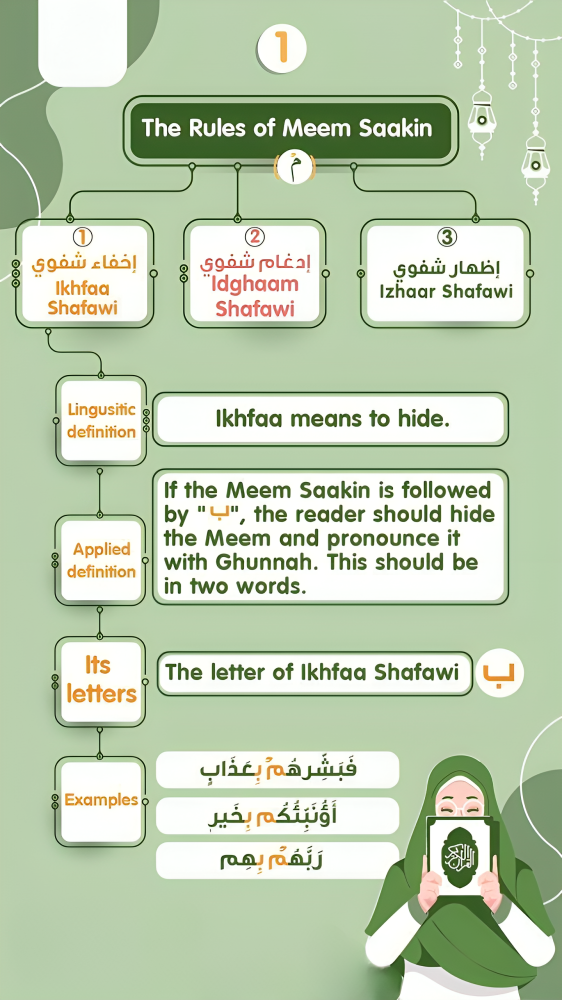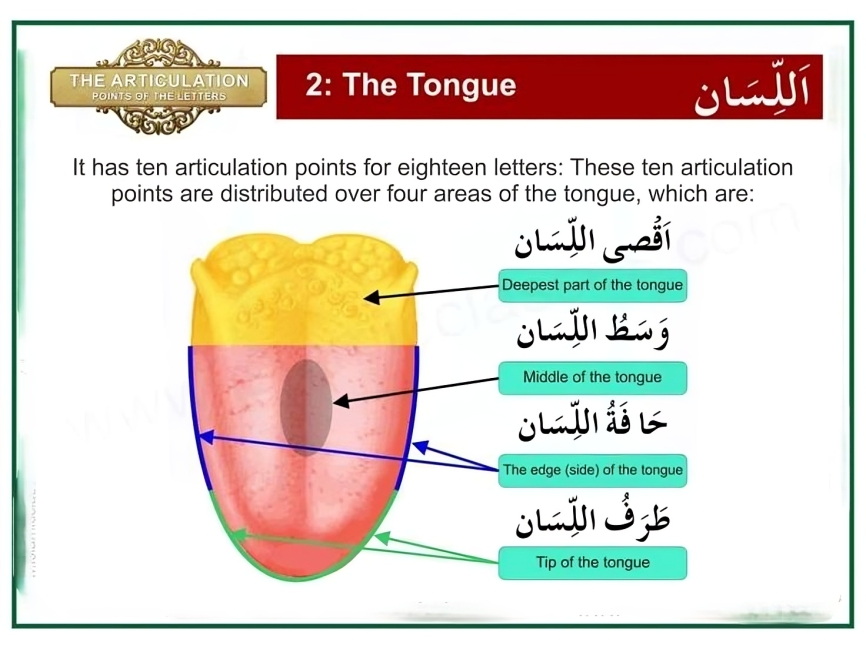Introduction
Ikhfa (الإخفاء), meaning “to hide” or “to conceal,” is one of the essential rules in Tajweed that governs the pronunciation of Noon Sakin (نْ) and Tanween (ــً ــٍ ــٌ) when they meet specific letters. This concealment creates a unique sound that lies between complete manifestation (Izhar) and complete merging (Idgham).
Understanding Ikhfa
Definition
Ikhfa is the partial concealment of Noon Sakin or Tanween when followed by any of the 15 Ikhfa letters. The pronunciation occurs with a nasal sound (Ghunnah) while maintaining characteristics of both letters.
The 15 Letters of Ikhfa
The letters are:
- ت (Ta)
- ث (Tha)
- ج (Jeem)
- د (Dal)
- ذ (Dhal)
- ز (Zay)
- س (Seen)
- ش (Sheen)
- ص (Sad)
- ض (Dad)
- ط (Ta)
- ظ (Dha)
- ف (Fa)
- ق (Qaf)
- ك (Kaf)
Memorization Tip: These letters can be remembered through the phrase:
صِفْ ذَا ثَنَا كَمْ جَادَ شَخْصٌ قَدْ سَمَا / دُمْ طَيِّباً زِدْ فِي تُقًى ضَعْ ظَالِمَا
Rules of Application
Basic Rules
- Duration of Ghunnah: 2 counts
- Partial concealment of Noon/Tanween
- Maintaining characteristics of both letters
- Clear nasalization
Types of Occurrences
1. With Noon Sakin
Examples:
- مِنْ تَحْتِهَا (Min Tahtiha)
- أَنْ جَاءَ (An Jaa’a)
- مَنْ ذَا (Man Dha)
2. With Tanween
Examples:
- عَلِيمٌ حَكِيمٌ (‘Aleemun Hakeem)
- يَوْمَئِذٍ تُحَدِّثُ (Yawma’idhin Tuhaddithu)
- قَوْلاً سَدِيداً (Qawlan Sadeeda)
Practical Implementation
Step-by-Step Guide
- Identify the Letter Combination
- Look for Noon Sakin or Tanween
- Check the following letter
- Confirm if it’s one of the 15 Ikhfa letters
- Proper Pronunciation
- Begin with slight nasalization
- Maintain 2-count duration
- Ensure partial concealment
- Complete the following letter clearly
- Common Applications
- Within words
- Between words
- At the end of verses
Common Mistakes to Avoid
1. Technical Errors
- Over-extending the Ghunnah
- Complete hiding of the Noon/Tanween
- Incorrect nasalization
- Wrong duration timing
2. Practical Mistakes
- Mixing with other rules
- Inconsistent application
- Poor breath control
- Incorrect letter identification
Learning Methodology
1. Progressive Learning
- Start with simple combinations
- Practice with individual words
- Advance to phrases
- Master continuous recitation
2. Practice Techniques
- Record and review
- Mirror practice
- Group learning
- Teacher supervision
3. Effective Tools
- Color-coded Quran
- Audio resources
- Practice worksheets
- Digital applications
Advanced Concepts
1. Special Cases
- Multiple occurrences
- Challenging combinations
- Verse-end applications
- Speed variations
2. Regional Variations
- Different recitation styles
- Acceptable variations
- School-specific approaches
Benefits of Proper Application
1. Recitation Quality
- Improved fluency
- Better pronunciation
- Enhanced rhythm
- Natural flow
2. Spiritual Benefits
- Greater connection
- Better understanding
- More rewarding recitation
- Authentic preservation
3. Learning Benefits
- Stronger foundation
- Better memorization
- Improved teaching ability
- Deeper appreciation
Practice Guidelines
1. Daily Routine
- Regular practice sessions
- Systematic approach
- Progressive difficulty
- Consistent review
2. Assessment Methods
- Self-recording
- Peer review
- Teacher feedback
- Progress tracking
3. Group Activities
- Partner practice
- Group recitation
- Teaching opportunities
- Feedback sessions
Using Modern Technology
1. Digital Resources
- Mobile applications
- Online tutorials
- Video lessons
- Interactive tools
2. Learning Platforms
- Virtual classrooms
- Online assessment
- Progress tracking
- Community support
Conclusion
Mastering Ikhfa is crucial for proper Quranic recitation. Through consistent practice, proper guidance, and understanding of the rules, students can achieve proficiency in this essential aspect of Tajweed. Remember that excellence in recitation is a journey that requires patience, dedication, and continuous learning.
About the Author
This comprehensive guide is published on Baytul Quran, your trusted source for Quranic learning and Tajweed education.
References and Resources
- Classical Tajweed texts
- Modern teaching methodologies
- Expert teacher insights
- Student learning experiences





